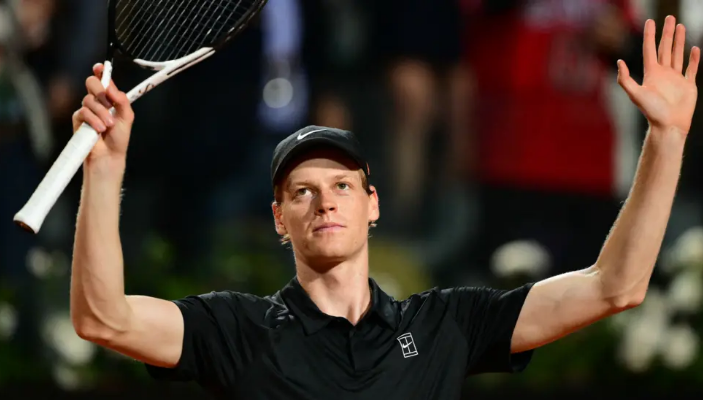Jannik Sinner, one of the most dynamic athletes in today’s professional tennis landscape, has steadily earned his place among the elite on the ATP tour. Born in 2001 in Italy, his early transition from skiing to tennis led to a focused, disciplined journey that reflects in his consistent game and mental resilience. This article presents an in-depth overview of Sinner’s growth, playing style, recent performance metrics, and his role in shaping the next generation of tennis.
Background: From San Candido to Global Courts
Sinner grew up in San Candido, a small alpine town in northern Italy. Originally a skiing prodigy, he shifted his focus entirely to tennis at the age of 13. This transition wasn’t typical, but it shaped the discipline and balance that now defines his court behavior. Trained at Riccardo Piatti’s academy—renowned for developing high-level players—Sinner quickly began to draw attention for his maturity and controlled aggression.
Game Style and Technical Analysis
Sinner plays a baseline-oriented game characterized by powerful groundstrokes, precision placement, and high rally tolerance. He generates notable pace from both wings, especially his flat, penetrating backhand—a key weapon in extended rallies.
Key Performance Features:
- Serve: Though not among the fastest servers on tour, Sinner’s serve placement and improvement in second-serve accuracy have significantly elevated his win percentage on service games.
- Return Game: His return strategy emphasizes early ball contact, neutralizing even big servers effectively on hard and indoor courts.
- Movement: Despite his height (6’2”), he moves efficiently across all surfaces, showing particular prowess on hard courts and faster indoor conditions.
Career Progression and ATP Rankings
Sinner’s professional debut came in 2018, but it was in 2020 that he entered broader tennis conversations. His breakthrough run at the 2020 French Open, where he reached the quarterfinals at just 19, highlighted his composure in high-pressure matches.
Career Highlights So Far:
- First ATP Title: Sofia Open, 2020
- First Grand Slam Semifinal: Wimbledon 2023
- Masters 1000 Title: Canadian Open 2023
- ATP Finals 2023: Runner-up finish
- Grand Slam Champion: Australian Open 2024
By early 2025, Sinner had climbed into the ATP top 3, consistently outperforming seasoned players and improving his head-to-head records.
Mental Strength and Match Temperament
What differentiates Sinner is his quiet intensity. Unlike more flamboyant contemporaries, he rarely shows extreme emotion on court. This calm approach helps him manage tight matches and tiebreak situations with remarkable poise.
According to match analysis, his unforced error count in close sets is among the lowest of top 10 players, pointing to his ability to stay focused under pressure.
Comparison with Contemporaries
Sinner is often discussed in the context of other young stars like Carlos Alcaraz and Holger Rune. While Alcaraz leans toward athletic explosiveness and Rune toward improvisation, Sinner’s game stands out for its efficiency, structured point construction, and high consistency.
| Player | Strength Highlight | Surface Proficiency |
|---|---|---|
| Jannik Sinner | Baseline consistency | Hard, Indoor |
| Alcaraz | Athleticism & court coverage | Clay, Grass |
| Rune | Shot creativity | Clay, Hard |
Recent Developments and Coaching Team
Since partnering with coach Darren Cahill, Sinner’s tactical approach has matured. Cahill’s experience, particularly with top-level players like Simona Halep and Andre Agassi, has added depth to Sinner’s decision-making in rallies and match planning.
Recent training footage and match stats show a clear shift: Sinner is using the court width more effectively and engaging in aggressive net play, something earlier absent in his game.
Injury Management and Physical Conditioning
One of the concerns early in Sinner’s career was physical endurance. However, in the past 18 months, there has been visible improvement in his conditioning. He now sustains long matches—especially in Grand Slam formats—without visible drop in energy or accuracy. His offseason training routines include core strength, reflex drills, and altitude running to build resilience.
Influence on Italian Tennis
Sinner’s success has triggered a renewed interest in tennis across Italy. With Matteo Berrettini struggling with injuries and Lorenzo Musetti still building his game, Sinner’s steady rise has inspired new grassroots programs across the country.
The Italian Tennis Federation has reported a 27% increase in youth tennis participation from 2022 to 2024—largely attributed to Sinner’s public image as a hardworking, grounded athlete.
What to Expect Ahead
With the 2025 US Open on the horizon, Sinner remains a strong title contender. His ranking points, performance on hard courts, and improved mental game make him a consistent threat in best-of-five formats. The tennis world is watching to see if he can continue this momentum, especially against top-seeded players in high-stakes environments.
Expectations are not just based on media hype—they’re grounded in match metrics, win-loss records, and his continuous effort to evolve tactically and physically.
Conclusion
Jannik Sinner represents more than just rising talent; he’s a signal of where modern tennis is headed—toward intelligent aggression, balanced athleticism, and sustainable performance. His career trajectory shows that growth is not always explosive; it can be methodical, stable, and deeply rooted in focus and discipline.
For tennis fans, analysts, and aspiring athletes, Sinner’s journey offers a blueprint for how mental strength, technical skill, and long-term vision can coexist at the highest levels of the sport.
